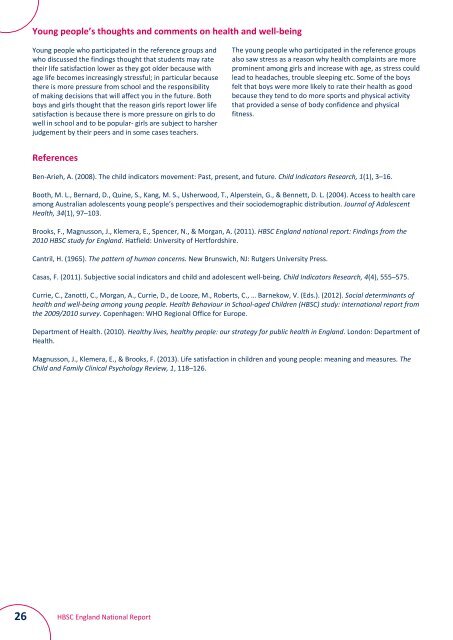health school
1PfRgAZ
1PfRgAZ
You also want an ePaper? Increase the reach of your titles
YUMPU automatically turns print PDFs into web optimized ePapers that Google loves.
Young people’s thoughts and comments on <strong>health</strong> and well-being<br />
Young people who participated in the reference groups and<br />
who discussed the findings thought that students may rate<br />
their life satisfaction lower as they got older because with<br />
age life becomes increasingly stressful; in particular because<br />
there is more pressure from <strong>school</strong> and the responsibility<br />
of making decisions that will affect you in the future. Both<br />
boys and girls thought that the reason girls report lower life<br />
satisfaction is because there is more pressure on girls to do<br />
well in <strong>school</strong> and to be popular- girls are subject to harsher<br />
judgement by their peers and in some cases teachers.<br />
The young people who participated in the reference groups<br />
also saw stress as a reason why <strong>health</strong> complaints are more<br />
prominent among girls and increase with age, as stress could<br />
lead to headaches, trouble sleeping etc. Some of the boys<br />
felt that boys were more likely to rate their <strong>health</strong> as good<br />
because they tend to do more sports and physical activity<br />
that provided a sense of body confidence and physical<br />
fitness.<br />
References<br />
Ben-Arieh, A. (2008). The child indicators movement: Past, present, and future. Child Indicators Research, 1(1), 3–16.<br />
Booth, M. L., Bernard, D., Quine, S., Kang, M. S., Usherwood, T., Alperstein, G., & Bennett, D. L. (2004). Access to <strong>health</strong> care<br />
among Australian adolescents young people’s perspectives and their sociodemographic distribution. Journal of Adolescent<br />
Health, 34(1), 97–103.<br />
Brooks, F., Magnusson, J., Klemera, E., Spencer, N., & Morgan, A. (2011). HBSC England national report: Findings from the<br />
2010 HBSC study for England. Hatfield: University of Hertfordshire.<br />
Cantril, H. (1965). The pattern of human concerns. New Brunswich, NJ: Rutgers University Press.<br />
Casas, F. (2011). Subjective social indicators and child and adolescent well-being. Child Indicators Research, 4(4), 555–575.<br />
Currie, C., Zanotti, C., Morgan, A., Currie, D., de Looze, M., Roberts, C., … Barnekow, V. (Eds.). (2012). Social determinants of<br />
<strong>health</strong> and well-being among young people. Health Behaviour in School-aged Children (HBSC) study: international report from<br />
the 2009/2010 survey. Copenhagen: WHO Regional Office for Europe.<br />
Department of Health. (2010). Healthy lives, <strong>health</strong>y people: our strategy for public <strong>health</strong> in England. London: Department of<br />
Health.<br />
Magnusson, J., Klemera, E., & Brooks, F. (2013). Life satisfaction in children and young people: meaning and measures. The<br />
Child and Family Clinical Psychology Review, 1, 118–126.<br />
26<br />
HBSC England National Report


